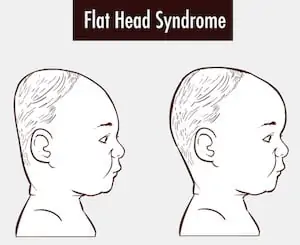Discovering that your baby has a flat head, often called plagiocephaly, can be quite a shocking moment. It’s relatively common, and most mild cases require no special treatment. Your baby’s flat head will correct itself over time.
That’s right; you don’t always need to invest in a helmet for months or physical therapies. In some cases, all your baby needs is time to correct the problem, assuming that make sure it doesn’t get worse by using appropriate techniques encouraged by your doctor.
Here’s what you need to know!
Can A Flat Head Really Correct Itself?
Yes! Mild plagiocephaly cases typically don’t require any treatment. In these cases, you’d expect your baby’s head to grow and fix itself as your child grows and develops.

This happens because your baby’s head shape naturally improves as his head grows. At the same time, his gross motor skills develop and change as well. Then, your baby spends less time on his back and more time on his tummy and sitting upwards because of newly developed neck muscles. That results in less pressure placed on the back of your baby’s head.
How Long Will It Take to Correct a Flat Head?
Your baby is doing a lot of growing in the first year of his life, and his head is a significant part of that. However, it will take time for your baby’s head to return to a healthy, rounded shape. By the time that your child is 1-2 years old, any flatness will be barely noticeable.
Now that’s not to say you won’t see improvements – you will! If your baby’s head is slowly correcting itself, you should notice within two months a difference. By four months, the difference will be significant to you; you spent the most time staring at your baby’s head.
How to Help Your Baby’s Head Correct Itself
If you want to do some things that can help your baby’s head correct itself a bit sooner, there are some things that you can try to do. Pediatricians and parents alike commonly recommend these tips.
- Be sure to reposition your baby often to avoid lying on the flat side of his head for long periods.
- Do gently stretches with your baby to improve neck movements and muscles.
- Give your baby plenty of tummy time to develop skills and muscles.
- Try using a pillow designed to help babies with flat heads. It can reduce the pressure on your baby’s head.
- Change how you hold your baby and what arms you use – repositioning is very helpful.
It Won’t Always Work This Way
If you find that your efforts to reposition your baby frequently make no difference, it’s unlikely that it will correct itself. At this time, your doctor will help you decide if your baby would benefit from a helmet.
While using a helmet sounds horrible, it’s only for a short period of your child’s life. A helmet is used when repositioning fails or if your baby is older and sitting or rolling over. It’s at this time that your baby’s head is malleable and easy to reshape.
Using a helmet is not painful and won’t restrict any growth. Babies get used to wearing a helmet, and since they’re manufactured for babies, they’re very lightweight and comfortable for babies.
Final Thoughts
In mild cases, your baby’s flat head will correct itself with repositioning techniques. It will take time, but after a few months, you’ll notice a difference in the flatness. Expect it to take a considerable amount of time to be completely rounded, but your doctor will ensure you stay on the right track.
Hey, this is Linda. My biggest accomplishment in life is being a mother of four children. Their current ages range from almost ten years old down to 20 months old.
I’m passionate about writing parenting articles because I understand so well all of the problems and trials you face as a parent. From breastfeeding woes to budgeting problems and behavior problems, along with everything in between, chances are I’ve faced it over the last ten years. Read more about Linda here.



